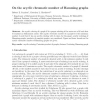5 search results - page 1 / 1 » The distinguishing chromatic number of Cartesian products of... |
DM
2010
13 years 5 months ago
2010
A labeling of a graph G is distinguishing if it is only preserved by the trivial automorphism of G. The distinguishing chromatic number of G is the smallest integer k such that G ...
SIAMDM
2010
13 years 3 months ago
2010
EJC
2008
13 years 4 months ago
2008
The distinguishing number D(G) of a graph G is the least integer d such that G has a labeling with d labels that is preserved only by a trivial automorphism. We prove that Cartesi...
JGT
2008
13 years 4 months ago
2008
: This article proves the following result: Let G and G be graphs of orders n and n , respectively. Let G be obtained from G by adding to each vertex a set of n degree 1 neighbors....
GC
2008
Springer
13 years 4 months ago
2008
Springer
An acyclic coloring of a graph G is a proper coloring of the vertex set of G such that G contains no bichromatic cycles. The acyclic chromatic number of a graph G is the minimum nu...

